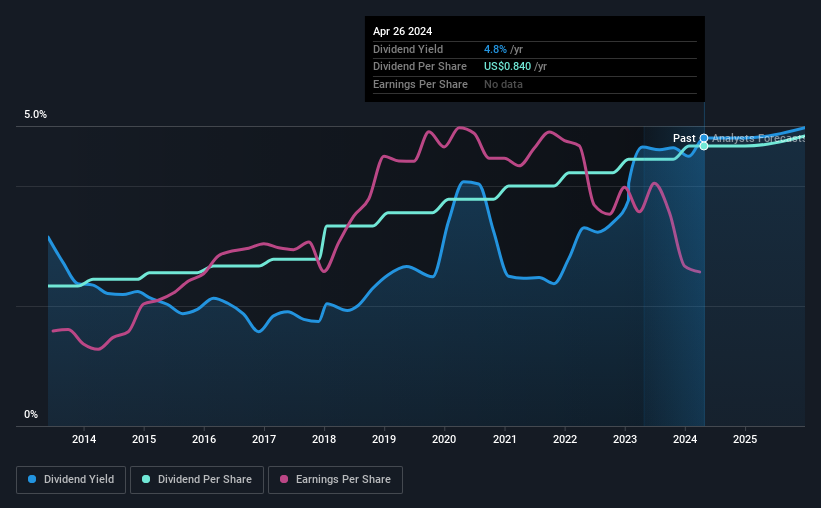- United States
- /
- Banks
- /
- NasdaqGS:SFNC
Simmons First National (NASDAQ:SFNC) Is Due To Pay A Dividend Of $0.21
Simmons First National Corporation (NASDAQ:SFNC) has announced that it will pay a dividend of $0.21 per share on the 1st of July. This makes the dividend yield 4.8%, which is above the industry average.
Check out our latest analysis for Simmons First National
Simmons First National's Payment Expected To Have Solid Earnings Coverage
If the payments aren't sustainable, a high yield for a few years won't matter that much.
Simmons First National has a long history of paying out dividends, with its current track record at a minimum of 10 years. Based on Simmons First National's last earnings report, the payout ratio is at a decent 61%, meaning that the company is able to pay out its dividend with a bit of room to spare.
Over the next year, EPS is forecast to expand by 8.2%. Assuming the dividend continues along recent trends, we think the future payout ratio could be 60% by next year, which is in a pretty sustainable range.

Simmons First National Has A Solid Track Record
The company has an extended history of paying stable dividends. The annual payment during the last 10 years was $0.42 in 2014, and the most recent fiscal year payment was $0.84. This implies that the company grew its distributions at a yearly rate of about 7.2% over that duration. The growth of the dividend has been pretty reliable, so we think this can offer investors some nice additional income in their portfolio.
The Dividend Has Limited Growth Potential
Investors could be attracted to the stock based on the quality of its payment history. However, things aren't all that rosy. Simmons First National's EPS has fallen by approximately 10% per year during the past five years. Such rapid declines definitely have the potential to constrain dividend payments if the trend continues into the future. On the bright side, earnings are predicted to gain some ground over the next year, but until this turns into a pattern we wouldn't be feeling too comfortable.
In Summary
Overall, it's great to see the dividend being raised and that it is still in a sustainable range. The earnings coverage is acceptable for now, but with earnings on the decline we would definitely keep an eye on the payout ratio. Taking all of this into consideration, the dividend looks viable moving forward, but investors should be mindful that the company has pushed the boundaries of sustainability in the past and may do so again.
Companies possessing a stable dividend policy will likely enjoy greater investor interest than those suffering from a more inconsistent approach. However, there are other things to consider for investors when analysing stock performance. Without at least some growth in earnings per share over time, the dividend will eventually come under pressure either from competition or inflation. See if the 6 analysts are forecasting a turnaround in our free collection of analyst estimates here. If you are a dividend investor, you might also want to look at our curated list of high yield dividend stocks.
New: Manage All Your Stock Portfolios in One Place
We've created the ultimate portfolio companion for stock investors, and it's free.
• Connect an unlimited number of Portfolios and see your total in one currency
• Be alerted to new Warning Signs or Risks via email or mobile
• Track the Fair Value of your stocks
Have feedback on this article? Concerned about the content? Get in touch with us directly. Alternatively, email editorial-team (at) simplywallst.com.
This article by Simply Wall St is general in nature. We provide commentary based on historical data and analyst forecasts only using an unbiased methodology and our articles are not intended to be financial advice. It does not constitute a recommendation to buy or sell any stock, and does not take account of your objectives, or your financial situation. We aim to bring you long-term focused analysis driven by fundamental data. Note that our analysis may not factor in the latest price-sensitive company announcements or qualitative material. Simply Wall St has no position in any stocks mentioned.
About NasdaqGS:SFNC
Simmons First National
Operates as the bank holding company for Simmons Bank that provides banking and other financial products and services to individuals and businesses.
Flawless balance sheet, good value and pays a dividend.
Similar Companies
Market Insights
Community Narratives




